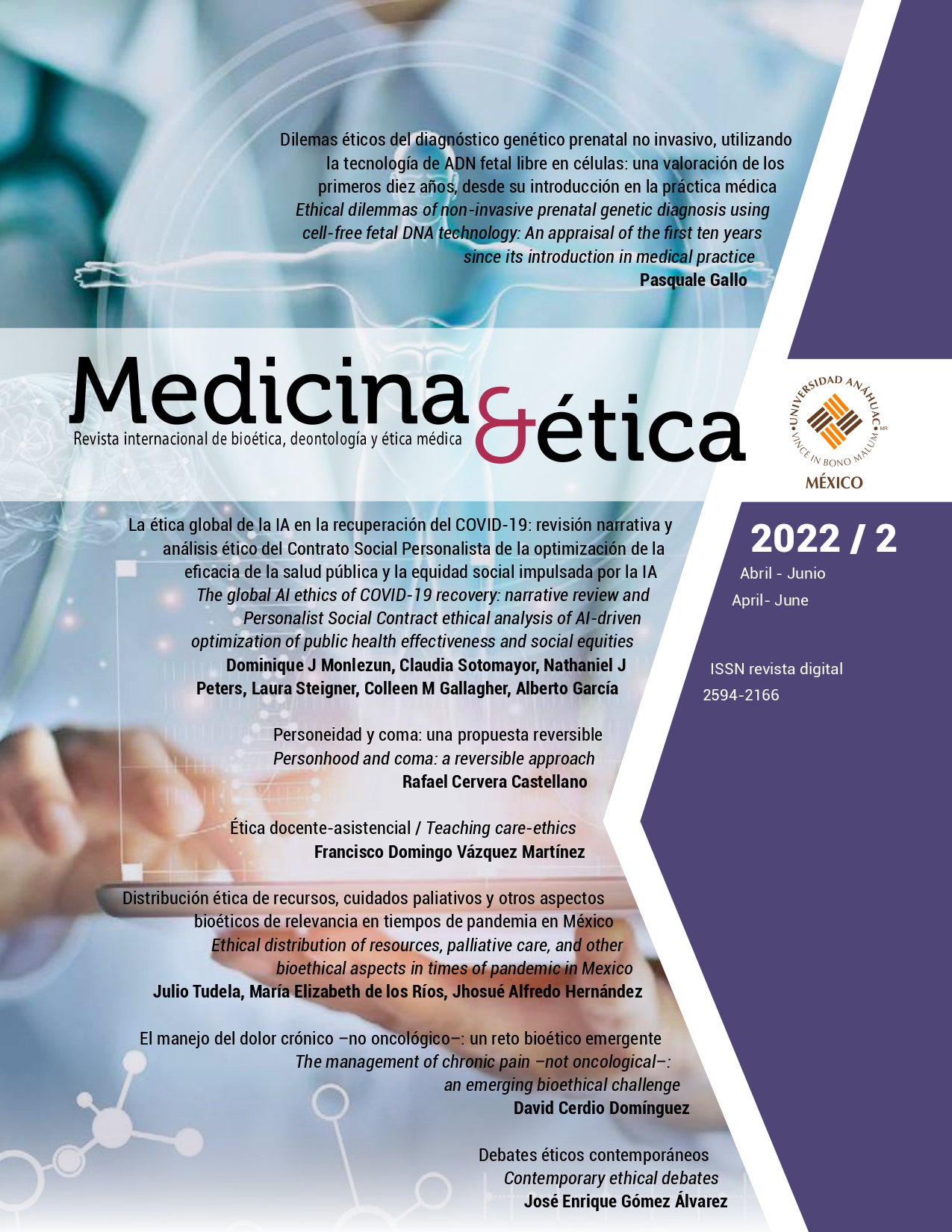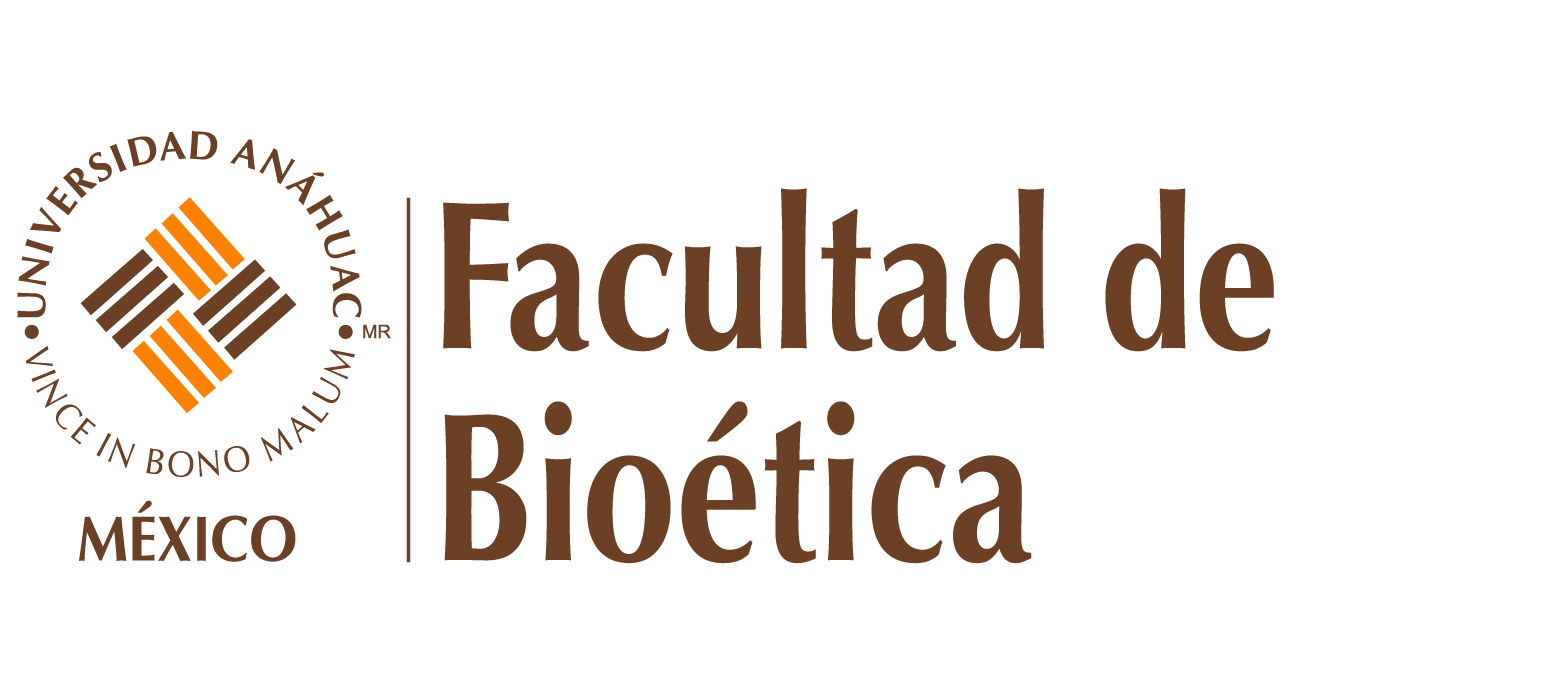Personeidad y coma: una propuesta reversible
DOI:
https://doi.org/10.36105/mye.2022v33n2.03Palabras clave:
persistencia, identidad, persona, comaResumen
La teoría de la persistencia psicológica define a las personas como seres capaces de crear un concepto de sí mismos mediante la continuidad en el tiempo de sus estados mentales. En los debates sobre la vida y la muerte de algunos humanos que han perdido sus facultades conscientes se discute sobre si son personas o no y, por tanto, si sería lícito terminar con sus vidas. El coma se presenta como contraejemplo de las teorías de la personeidad, que justifican el derecho a la vida a partir de la persistencia psicológica del individuo. Este derecho sería otorgado, no en términos de persistencia o continuidad mental, sino por las condiciones que hacen posible su pronta recuperación en el marco clínico de la enfermedad.
Descargas
Referencias
Locke J. Ensayo sobre el entendimiento humano. Trad. de Edmundo O’Gorman. México: Fondo de Cultura Económica; 2005. Texto original en inglés (1690).
McMahan J. The Ethics of Killing. NY, USA: Oxford University Press; 2002. https://doi.org/10.1093/0195079981.001.0001
Varner GE. Personhood, Ethics, and Animal Cognition. NY, USA: Oxford University Press; 2012. https://doi.org/10.1093/acprof:oso/9780199758784.001.0001
Schechtman M. The constitution of selves. NY, USA: Cornell University Press; 1997.
Schechtman M. The size of the self: Minimalist selves and narrative self-constitution. En: Narrative, psychology and life. Ed. Allen Speight. Boston Studies in Philosophy, Religion and Public Life, 2. Springer. Boston, MA, USA. 2015; 33-47. https://doi.org/10.1007/978-94-017-9349-0_3
Singer P. Practical ethics. 2nd. Edition. Cambridge, UK: Cambridge University Press; 1993.
Tooley M. Abortion and Infanticide. Oxford University Press. NY, USA: 1983.
Di Silvestro R. Human Capacities and Moral Status. Philosophy and Medicine, 108. NY, USA: Springer; 2010. https://doi.org/10.1007/978-90-481-8537-5
De Grazia D. Human Identity and Bioethics. NY, USA: Cambridge University Press; 2005. https://doi.org/10.1017/CBO9780511614484
Singer P. Rethinking Life & Death. NY, USA: St. Martin’s Press; 1994.
Nelson K. Narrative and the emergence of consciousness of self. En: Gary D, Fireman Ted E, McVay Jr y Owen J. Flanagan (Eds.), Narrative and Consciousness. NY, USA: Oxford University Press. 2003; 17-36. https://doi.org/10.1093/acprof:oso/9780195140057.003.0002
Tooley M. Abortion and Infanticide. Philosophy and Public Affairs. 1972; 2(1): 37-65.
Olson ET. The Human Animal. Personal Identity Without Psychology. NY, USA: Oxford University Press; 1997.
Edlow JA, Rabinstein A, Traub SJ, Wijdicks EF. Diagnosis of reversible causes of coma. Lancet. 2014; 384(9959): 2064-2076. https://doi.org/10.1016/S0140-6736(13)62184-4
Posner JB, Saper CB, Schiff ND, Plum F. The diagnosis of stupor and coma. Contemporary Neurology Series. 4a edición. NY, USA: Oxford University Press; 2007. https://doi.org/10.1093/med/9780195321319.001.0001
Di Silvestro R. Capacities, hierarchies, and the moral status of normal human infants and fetuses. Journal of Value Inquiry. 2009; 43: 479-492. https://doi.org/10.1007/s10790-009-9172-x
De Grazia D. Taking Animals Seriously. Mental Life and Moral Status. NY, USA: Cambridge University Press; 1996. https://doi.org/10.1017/CBO9781139172967
Nelson JL. Animals, handicapped children and the tragedy of marginal cases. Journal of Medical Ethics. 1988; 14: 191-193. https://doi.org/10.1136/jme.14.4.191
Tooley M. Personhood. En: A companion to Bioethics. 2a edición. Helga Kuhse and Peter Singer (eds.). Blackwell Publishing Ltd. 2009; 129-140.
McMahan J. Infanticide. Utilitas. 2007; 19(2): 131-159. https://doi.org/10.1017/s0953820807002440
De Grazia D. The distinction between equality in moral status and deserving equal consideration. Between the species, an online journal for the study of philosophy and animals. 1991; 7(2). https://doi.org/10.15368/bts.1991v7n2.2
De Grazia D. Human identity and bioethics. NY, USA: Cambridge University Press; 2005. https://doi.org/10.1017/CBO9780511614484
Pluhar E. Beyond prejudice: The moral significance of human and nonhuman animals. Durham, UK: Duke University Press; 1995. https://doi.org/10.1515/9780822396048
Baker RL. Persons and bodies. A constitution view. Cambridge, UK: Cambridge University Press; 2000. https://doi.org/10.1017/CBO9781139173124
Warren MA. Moral status: Obligations to persons and other living things. Oxford: Oxford University Press; 1997.
Mauss M. A category of the human mind: The notion of the person; the notion of self. Trad. por: Halls WD. En: Michael Carrithers, Steven Collins, Steven Lukes, (Eds.) The category of the person. Anthropology, philosophy, history. London, UK: Cambridge University Press. 1985; 1-25.
Schirmer JE. Artificial intelligence and legal personality: Introducing «Teilrechtsfa higkeit»: A partial legal status made in Germany. En: Regulating artificial intelligence. Eds. Wischmeyer T, Rademacher T. Springer; 2020. https://doi.org/10.1007/978-3-030-32361-5
Turner J. Robot rules. Regulating artificial intelligence. London, UK: Palgrave Macmillan; 2019. https://doi.org/10.1007/978-3-31996235-1
Andrews K. Animal mind. An introduction of the philosophy of animal cognition. NY, USA: Routledge; 2015.
De Grazia D. Great apes, dolphins, and the concept of personhood. The Southern Journal of Philosophy. 1997; XXXV. https://doi.org/10.1111/j.2041-6962.1997.tb00839.x
De Grazia D. Persons, dolphins, and non-human chimeras. The American Journal of Bioethics. 2014; 14(2), 17-18. https://doi.org/10.1080/15265161.2014.869434
McMahan J. Infanticide and moral consistency. Medical Ethics. 2013; 39, 273-280. https://doi.org/10.1136/medethics-2012-100988
De Grazia D. Equal consideration and unequal moral status. The Southern Journal of Philosophy. 1993; XXXI (1). https://doi.org/10.1111/j.2041-6962.1993.tb00667.x
Midgley M. Animals and why they matter. Athens, Georgia, USA: University of Georgia Press; 1983.
Regan T. The case for animal rights. Updated with a new preface. Berkeley, USA: University of California Press; 2004.
Sapontzis SF. Morals, reason, and animals. Philadelphia, USA: Temple University Press; 1987.
Sapontzis SF. Animal rights and biomedical research. The Journal of Value Inquiry. 1992; 26: 73-86. https://doi.org/10.1007/BF00136591
Singer P. Animal liberation: A new ethics for our treatment of animals. NY, USA: New York Review of Books; 1975.
Dennett DC. The self as a center of narrative gravity. En: Kessel F, Cole P y Johnson D. (eds.), Self and consciousness: Multiple perspectives. NY, USA: Psychology Press. 1992; 103-114.
Nelson K. Narrative and the emergence of consciousness of self. En: Gary D, Fireman Ted E, McVay Jr y Owen J Flanagan (eds.), Narrative and consciousness. NY, USA: Oxford University Press. 2003; 17-36. https://doi.org/10.1093/acprof:oso/9780195140057.003.0002
Macintyre A. After virtue: A study in moral theory. Segunda Edición. Notre Dame, Indiana, USA: University of Notre Dame Press; 1984.
Ricoeur P. Temps et recit III: Le temps raconte. Paris: Editions du Seuil; Time and Narrative III. Trans. K. Blamey and D. Pellauer. Chicago: Chicago University Press; 1988. https://doi.org/10.7208/chicago/9780226713533.001.0001
Taylor C. Sources of the self. The making of the modern identity. Cambridge, Massachusetts, USA: Harvard University Press; 1989.
Ryder R. Experiments on animals. En: S. & R. Godlovitch & J. Harris (eds.), Animals, men and morals. NY, USA: Taplinger; 1972.
Bermúdez JL. The moral significance of birth. Ethics. 1996; 106(2): 378-403. https://doi.org/10.1086/233622
Swinburne RG. Persons and personal identity. En: HD Lewis (ed.) Contemporary British Philosophy. London, UK: Allen & Unwin. 1976; 231-247.
Noonan HW. Personal identity. Second Edition. NY, USA: Routledge; 2003. https://doi.org/10.4324/9780203428351
Schnakers C, Majerus S. Behavioral assessment and diagnosis of disorders of consciousness. En: Schnakers C, Laureys S. (Eds.). Coma and disorders of consciousness. 2018; 1-16. https://doi.org/10.1007/978-3-319-55964-3_1
Stevens RD, Bhardwaj A. Approach to the comatose patient. Critical Care Medicine. 2006; 34: 31-41. https://doi.org/10.1097/01.CCM.0000194534.42661.9F
Wijdicks EF. The bare essentials: coma. Practical Neurology. 2010; 10: 51-60. https://doi.org/10.1136/jnnp.2009.200097
Multi-Society Task Force on PVS. Medical aspects of the persistent vegetative state. New England Journal of Medicine. 1994; 330: 1499-1508. https://doi.org/10.1056/NEJM199405263302107
Plum F, Posner JB. The diagnosis of stupor and coma. Contemporary Neurology Series, 19. 3a edición. NY, USA: Oxford Univertsity Press; 1980.
Mollaret P, Goulon M. The depassed coma (preliminary memoir). Revue Neurologique. 1959; 101: 3-15.
Maruya J, Endoh H, Watanabe H, Motoyama H, Abe H. Rapid improvement of diffusion-weighted imaging abnormalities after glucose infusion in hypoglycaemic coma. Journal of Neurology, Neurosurgery and Psychiatry. 2007; 78: 102-103. https://doi.org/10.1136/jnnp.2006.096776
Descargas
Publicado
Número
Sección
Licencia

Esta obra está bajo una licencia internacional Creative Commons Atribución-NoComercial-CompartirIgual 4.0.
Medicina y Ética se distribuye bajo Licencia Creative Commons Atribución-NoComercial-CompartirIgual 4.0 Internacional.
El autor conserva los derechos patrimoniales sin restricciones y garantiza a la revista el derecho de ser la primera publicación del trabajo. El autor es libre de depositar la versión publicada en cualquier otro medio, como un repositorio institucional o en su propio sitio web.




























